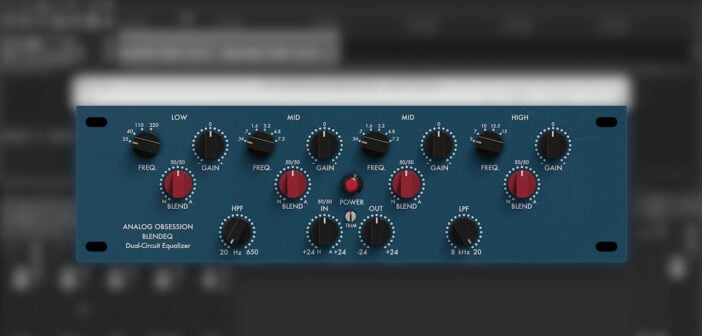Analog Obsession releases BlendEQ, the latest addition to an incredible collection of free VST plugins.
BlendEQ is a four-band, dual-circuit equalizer with pre-filters that combines two different EQ models with matched frequencies.
In true Analog Obsession style, the EQ units in question have single-letter names representing the original hardware units. First, we have A, a famous American EQ, and N, a famous non-American EQ.
In terms of sound, Analog Obsession describes equalizer A as punchier with more smack and equalizer N as the smoother of the two. Equalizer A will sound more squashed, while N is great for silky highs.
The concept for this plugin is clever, which isn’t surprising from this talented developer. BlendEQ allows you to blend the two parallel equalizers band by band. So, as you’ll see on the GUI, each frequency band has a dedicated 50/50 Blend knob.
The idea of blending each band however you like creates countless possibilities and probably a lot of welcome surprise results. If you don’t want to blend each range one by one, you can click on the BlendEQ label to link all Blend knobs to the Low Band Blend knob, letting you control all from one place.
While we’re talking about clicking on labels, the Analog Obsession label will engage 4X oversampling.
You can also blend the line amps, represented by the IN knob. All the way right is the A line amp (+24dB), and all the way left is the N line amp (+24dB).
The filters (LPF and HPF) are positioned before the line amps, helping the line amps process only the necessary frequency range.
The last Analog Obsession plugin we looked at was Frank, and if you haven’t seen it yet, go check it out. No matter how many plugins we cover, I still want to say how awesome it is that all of them are free!
If you want to support the developer financially, you can become a Patreon, starting at $5 per month.
BlendEQ is available in AU, VST, and VST3 formats for macOS (10.9-11) and Windows (7/8/10/11).
Download: BlendEQ
More:



9 Comments
JoeHF
onVery neat idea! So, apologies if this is a dumb question, but I gotta ask, because you never know… If there’s already an in-gain, an out-gain, and individual freq channel gain knobs, what’s the trim pot for? Secret sauce? Just curious. Thanks for posting, and thx AO for making so many excellent hardware-ish fx!
mx
oni have not tried it myself, but just looking at it: the “in gain” doesnt seem to be a usual in gain, but rather something like a balance of pushing more signal into the a or the n side.
i would suppose you can use one of the sides of each band then as a more coloured thing and the other side as a cleaner side, and use the trim pot for actually adjusting the input gain in front of the whole device.
mx
oni had not read the article before writing my comment, was just interested in the comment section…i should have read it, and joehf could have found a part of the answer to his question there too…
JoeHF
onAh, ok… I apparently didn’t connect that the numbers on the IN knob would be more about the amount of type-blending going on than the amt of gain. But ok, it’s a unique EQ, so I guess that works–thanks!
Bruno de Souza Lino
onOne of the biggest drawbacks of AO plugins still is the auto gain. For some reason, Tunca doesn’t want us to set the gain staging wrong or experiment with pushing his plugins…Even on the distortion ones.
mx
onam i misunderstanding your point?
actually autogain doesnt have to do with sound inside the plugin, it should correct just the pure level going out of the plugin without changing the sound which is created before the output stage.
so a plugin with autogain should be even better for experimenting with its settings and pushing it into distortion, because you can push it as far as you want without any change of volume coming out of the plugin in theory.
>thats the purpose of autogain
ss
onThe auto gain is one of my favorite features of his plugins!
Tobi
onwhich “famous American EQ” we talk about?
Rite mix
onOk